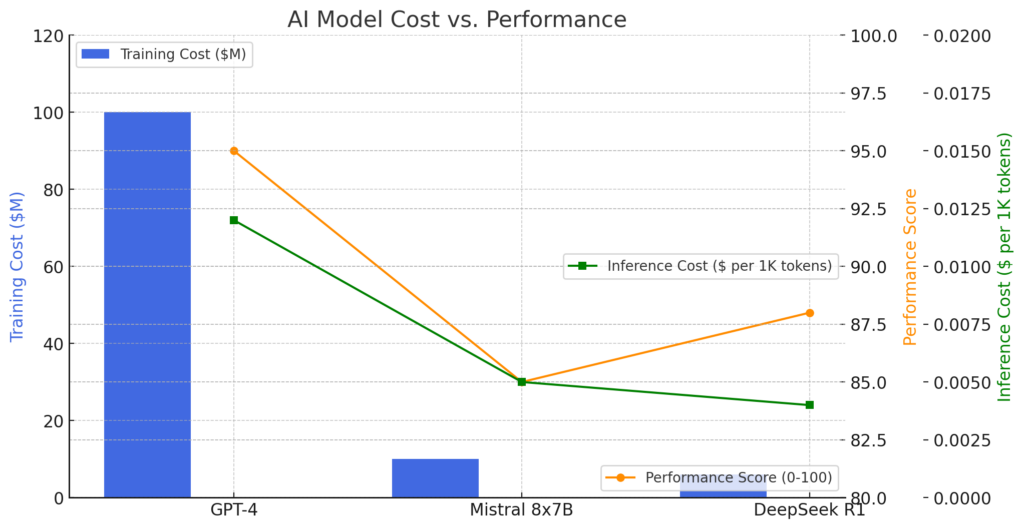The future of open-source AI is transforming modern technology, reshaping industries from search engines to healthcare diagnostics. For years, companies like OpenAI, Google DeepMind, and Meta AI have dominated the field, leading advancements in large language models (LLMs) such as GPT-4 and Gemini. However, the AI landscape is undergoing a dramatic shift, with open-source AI challengers like Mistral AI from Europe and DeepSeek from China rising as competitive alternatives.
As organizations seek more transparent, cost-effective, and customizable AI solutions, these open-source challengers are gaining traction. The question remains: Can Mistral and DeepSeek truly compete with OpenAI? This article explores the evolving landscape of AI, comparing proprietary and open-source approaches, and analyzing the potential impact of these emerging competitors.
OpenAI’s Market Dominance
The Power of Proprietary AI
OpenAI has established itself as the leading force in AI research and application. With the introduction of the GPT series, OpenAI has revolutionized content generation, coding assistance, and enterprise AI solutions. Backed by Microsoft, OpenAI has secured billions in funding, allowing it to train models on massive datasets with cutting-edge infrastructure.
Microsoft’s Strategic Investment
Microsoft’s collaboration with OpenAI extends beyond funding. The integration of OpenAI’s models into Microsoft Azure provides businesses with seamless access to advanced AI capabilities. Copilot, a product built on OpenAI’s models, is transforming software development, document generation, and customer service automation.
The Cost Factor
However, OpenAI’s models come at a price. Accessing GPT-4 for high-volume commercial applications requires significant financial investment, making it less accessible for smaller organizations and developers.
The Rise of Open-Source AI
Why Open-Source AI is Gaining Popularity
- Transparency & Security – Open-source models allow developers to inspect, modify, and fine-tune them for specific applications.
- Cost-Effectiveness – Unlike OpenAI’s subscription-based models, open-source alternatives reduce operational costs.
- Customization – Organizations can tailor models to their unique needs without being locked into proprietary ecosystems.
- Community-Driven Innovation – Open-source AI benefits from a global community of researchers, constantly improving models and fixing biases.
Key Open-Source AI Projects
- Meta’s Llama series
- Stability AI’s StableLM
- Hugging Face’s transformer models
- Mistral AI and DeepSeek as the latest entrants
DeepSeek: China’s AI Disruptor
The Origins of DeepSeek
DeepSeek, founded in 2023, quickly rose to prominence with its cost-effective AI development approach. Unlike OpenAI, which invests hundreds of millions in model training, DeepSeek has leveraged innovative techniques to create high-performance models with significantly lower costs.
Technological Innovations in DeepSeek R1
- Cost-Effective Training – DeepSeek R1 was trained for only $6 million compared to GPT-4’s estimated $100 million.
- Performance Benchmarks – Outperforms OpenAI’s O3 Mini in math, coding, and reasoning tasks.
- Architectural Differences – DeepSeek’s model leverages a mixture of expert layers, while OpenAI relies on a monolithic transformer architecture.
- Scalability & Adaptability – Designed to run efficiently on both cloud and on-premise hardware.
Market Adoption & Challenges
- Enterprise Adoption – DeepSeek has seen significant uptake in Asia but faces hurdles in Western markets.
- Security Concerns – US and European policymakers have raised concerns over data privacy and potential misuse.
- Operational Costs – While training is cheaper, the cost of maintaining and running AI models at scale remains a challenge.
Mistral AI: Europe’s Open-Source Champion
The Foundation of Mistral AI
Founded by former engineers from Meta and Google DeepMind, Mistral AI has positioned itself as Europe’s most promising AI startup. Unlike proprietary AI firms, Mistral AI advocates for open-weight LLMs, enabling unrestricted model access.
Mistral’s Open-Source Strategy
- Mistral 7B & Mixtral 8x7B – Competitive models designed to match GPT-4-level performance.
- Ethical AI Development – Focuses on eliminating bias and improving AI alignment.
- Regulatory Compliance – Works closely with the EU to adhere to strict AI governance policies.
Challenges and Adoption Hurdles
Mistral AI’s biggest challenge lies in securing enterprise adoption. While tech startups readily embrace open-source models, larger corporations often prefer the reliability and support of proprietary solutions like GPT-4 and Gemini.
Market and Cost Analysis

| Feature | DeepSeek R1 | Mistral AI | OpenAI GPT-4 |
|---|---|---|---|
| Cost to Train | $6M | $10M | $100M |
| Operational Cost | Medium | Medium | High |
| Open Source | Limited | Yes | No |
| Performance | High | Very High | Best-in-Class |
| Enterprise Adoption | Limited | Growing | High |
| Regulatory Hurdles | Yes | No | No |
Future Predictions and Expert Insights
Where is Open-Source AI Headed?
- Technological Breakthroughs – The rise of smaller, more efficient models will make open-source AI more competitive.
- Market Expansion – More enterprises will explore open-source alternatives to reduce costs.
- Regulatory Landscape – Stricter regulations may either slow down or legitimize open-source models in the long term.
- Industry-Specific Applications – AI will become increasingly specialized, with tailored models for healthcare, finance, and legal applications.
Expert Opinions
Industry analysts predict that by 2027, open-source AI will account for 40% of AI deployments in enterprises. AI ethics researchers emphasize that while open models reduce bias, they require more governance frameworks to prevent misuse.
Conclusion
Mistral AI and DeepSeek represent the next wave of AI innovation, proving that open-source models can compete with proprietary giants like OpenAI. While challenges exist—ranging from regulatory barriers to enterprise adoption—these startups are paving the way for a more accessible, cost-effective, and transparent AI future.
As the AI landscape continues to evolve, the competition between proprietary and open-source AI will shape the future of technology, influencing everything from business automation to academic research and global policy-making.
Reference Section
For further insights and supporting data, explore the following references:
- OpenAI’s GPT-4: https://openai.com/research/gpt-4
- DeepSeek R1 Overview: https://deepseek.com/models/r1
- Mistral AI’s Open-Source Models: https://mistral.ai
- AI Market Trends and Predictions (McKinsey Report): https://www.mckinsey.com/business-functions/mckinsey-digital/our-insights/ai-market-trends-2025
- European AI Regulation: https://digital-strategy.ec.europa.eu/en/policies/artificial-intelligence
- Open-Source AI Ethics and Risks (Stanford AI Index): https://aiindex.stanford.edu





Leave a Reply